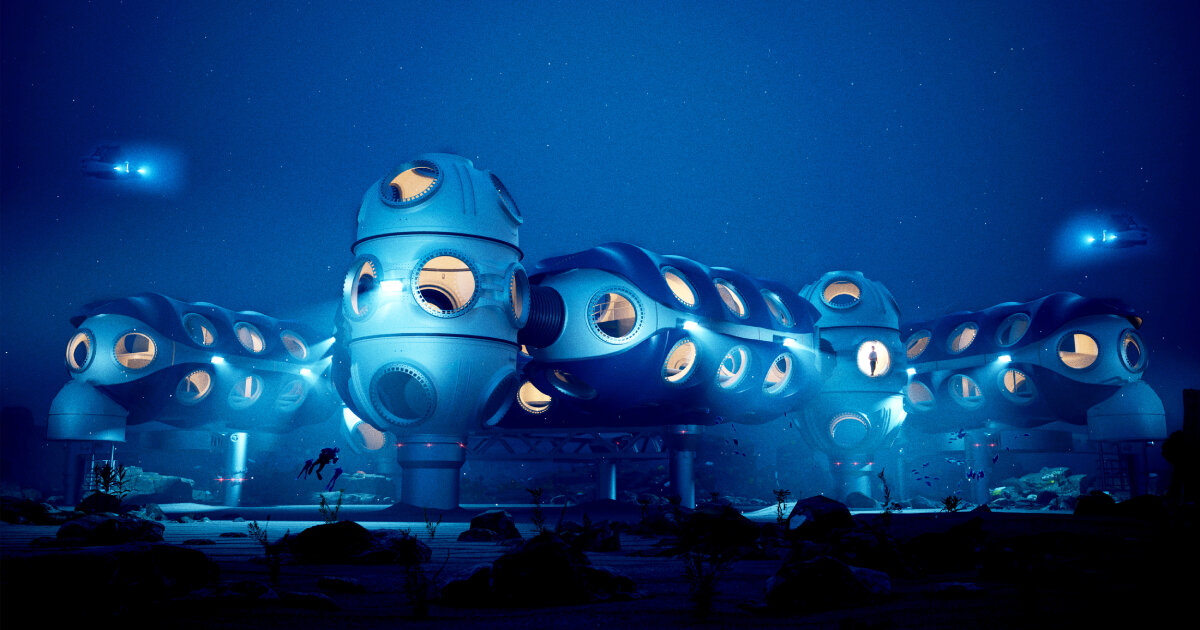There are two things in common with the deep sea and the starry night sky: the harshness, vastness, and unwavering mystery of the unknown that make the allure of space and marine exploration so attractive. That leads to the second similarity—we don’t know much about either realm, despite humanity’s efforts to pursue knowledge. However, since the Soviet Union launched the satellite Sputnik 1 into space in 1957, focus and funds have primarily shifted towards the galaxy, while the ocean floor has remained largely untouched. DEEP is planning to change that.
DEEP is an ocean research company that develops ways to further our understanding of the world beneath our feet. While its overall focus is facilitating aquatic research, the company’s main mission is to “Make Humans Aquatic” by 2027, which will be accomplished through its latest invention: The Sentinel.
The fantasy of living underwater among fascinating marine animals and beautiful reefs has never been closer than now with the technology of the Sentinel, but what is a Sentinel? It is an autonomous Inconel module created to withstand the ambient pressure of the ocean and designed to be a living space while doubling as a research facility. It can house a 6-person team to a 50-person crew, and one module has a service life of 20 years.
The Sentinel has a plethora of built-in features that make it a comfortable and safe environment. These benefits include customizable modular components, short—and long-term deployment, reusability, and autonomous systems.
To start, the Sentinel’s design includes holes around its entire base that seem like windows, but in reality, their function is to allow multiple modules to connect. This ability to attach Sentinel to Sentinel forms a near-endless possibility of configurations, so the buyer or lessee has a lot of flexibility and customization on how they want the subsea habitat to appear. In addition, there is a possibility of entire villages living underwater because of this adaptability.
This personalization aspect is important for particular groups of people—marine biologists, oceanographers, and divers. It is helpful to them because they can reconfigure the habitat to suit the conditions needed for their research and experiments. In this way, the Sentinel is multi-use. They can also live underwater for up to a month or 28 days, which is ample time to collect hands-on data for their studies.
Specifically, on the Sentinel’s page of the official DEEP website, it explains, “Sentinel fills a technology gap unserved by diving or submersible methods, allowing people to live and work underwater for longer periods and unlock new discoveries.” This is imperative because breakthroughs will often lead to advancements in civilization, and in the end, can benefit many of us in our daily lives. A key example of how ocean research is useful is the many medicines derived from marine life. The Tectitethya crypta is a sponge found in the Caribbean Sea that produces a compound that is used in all sorts of medical treatments, like the first ever anti-leukemia drug, zidovudine (AZT), and many other antiviral or anti-cancer medications.
The Sentinel is reusable, and therefore more efficiently sustainable. To explain, modules last about 20 years, but in that time, the Sentinels can be packed up and relocated to nearly anywhere in the world. This is important because it saves the company material rather than having to make a new module for every purchase and customer. Another benefit is that operators can conduct multiple large-scale or side projects at once.
Last but not least, the Sentinel is uniquely autonomous. Other subsea habitats usually depend on Diving Support Vessels (DSV)—ships that act as a floating platform and are specialized in diving excursions. Unfortunately, they often elevate environmental costs and expose operations to the climate.
On the DEEP Sentinel’s webpage, they explain how they have counteracted this problem. “Sentinel’s power systems are based on a micro-grid architecture and are designed to work with DEEP’s renewable power and satellite communications buoy.” This means that instead of relying on a DSV to stay in touch with the surface or get power, they have their own system they use.
The unique micro-grid architecture can allow the Sentinel to still provide power even through outages, and the buoys can send live data. It sources electricity through wind turbines and solar panels, while the latter will have a Starlink interface installed, so the Sentinel can be equipped with high-speed internet.
To make any underwater facility, there has to be a guarantee of safety and support in its walls and infrastructure. The company uses a specific method called Wire Arc Additive Manufacturing (WAAM) to create structures efficiently and cost-effectively. This is a technique where a group of 6 machines with robotic arm welders will essentially 3D print the modules by layering sheets of metal Inconel. They are even able to reinforce certain areas in the Sentinel that experience the most force in the ocean.
The Sentinel sounds great in theory, but why will this be so significant? Humans explore the sea for a variety of reasons, including deepening our understanding of this planet, preserving and protecting ecosystems, as well as studying how the oceans affect things around them. None of this would be possible if scientists could not gather accurate and reliable data. What better way to gather information than a hands-on approach—swimming and diving with the very animals and habitat they study. With the Sentinel, oceanographers can get to know the deep and feel the environment for themselves for longer durations.
The Sentinel’s multi-use, customizability, and autonomous features will most definitely benefit marine scientists/researchers in the very near future. Goals will shift and breakthroughs will occur as a new age of ocean exploration is presented, and the Sentinel will be the one revolutionizing it all. One day, you might even find yourself in an underwater module, gearing up to exit the Sentinel for another day of ocean exploration.






















